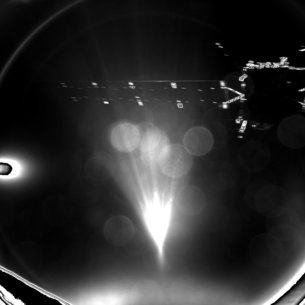
 On Nov. 12, ESA’s Rosetta mission made history by soft-landing its Philae probe on a comet, the first time such an extraordinary feat has been achieved.
On Nov. 12, ESA’s Rosetta mission made history by soft-landing its Philae probe on a comet, the first time such an extraordinary feat has been achieved.
After a tense wait during the seven-hour descent to the surface of Comet 67P/Churyumov-Gerasimenko, the signal confirming the successful touchdown arrived on Earth at 16:03 GMT (8:03 a.m. PST).
“Our ambitious Rosetta mission has secured a place in the history books: not only is it the first to rendezvous with and orbit a comet, but it is now also the first to deliver a lander to a comet’s surface,” noted Jean-Jacques Dordain, ESA’s Director General.
Rosetta was launched on 2 March 2004 and travelled 6.4 billion kilometers through the solar system before arriving at the comet on 6 August 2014.
The landing site, named Agilkia and located on the head of the bizarre double-lobed object, was chosen just six weeks after arrival based on images and data collected at distances of 30-100 km from the comet. Those first images soon revealed the comet as a world littered with boulders, towering cliffs and daunting precipices and pits, with jets of gas and dust streaming from the surface.
During its seven-hour descent, which was made without propulsion or guidance, Philae took images and recorded information about the comet’s environment.
Touchdown was planned to take place at a speed of around 1 m/s, with the three-legged landing gear absorbing the impact to prevent rebound, and an ice screw in each foot driving into the surface.
But during the final health checks of the lander before separation, a problem was detected with the small thruster on top that was designed to counteract the recoil of the harpoons to push the lander down onto the surface. The conditions of landing—including whether or not the thruster performed—along with the exact location of Philae on the comet, are being analyzed.
Over the first 2.5 days after its landing, Philae will conduct its primary science mission,  assuming that its main battery remains in good health. An extended science phase using the rechargeable secondary battery may be possible, assuming Sun illumination conditions allow and dust settling on the solar panels does not prevent it. This extended phase could last until March 2015, after which conditions inside the lander are expected to be too hot for (due to the comet’s approach to the Sun) it to continue operating.
assuming that its main battery remains in good health. An extended science phase using the rechargeable secondary battery may be possible, assuming Sun illumination conditions allow and dust settling on the solar panels does not prevent it. This extended phase could last until March 2015, after which conditions inside the lander are expected to be too hot for (due to the comet’s approach to the Sun) it to continue operating.
Science highlights from the primary phase will include a full panoramic view of the landing site, including a section in 3D, high-resolution images of the surface immediately underneath the lander, on-the-spot analysis of the composition of the comet’s surface materials, and a drill that will take samples from a depth of 23 cm and feed them to an onboard laboratory for analysis.
The lander will also measure the electrical and mechanical characteristics of the surface. In addition, low-frequency radio signals will be beamed between Philae and the orbiter through the nucleus to probe the internal structure.
Next year, as the comet grows more active, Rosetta will need to step further back and fly unbound ‘orbits’, but dipping in briefly with daring flybys, some of which will bring it within just 8 km of the comet center.
The comet will reach its closest distance to the Sun on 13 August 2015 at about 185 million km, roughly between the orbits of Earth and Mars. Rosetta will follow it throughout the remainder of 2015, as they head away from the Sun and activity begins to subside.
Photos courtesy of European Space Agency


Be the first to comment